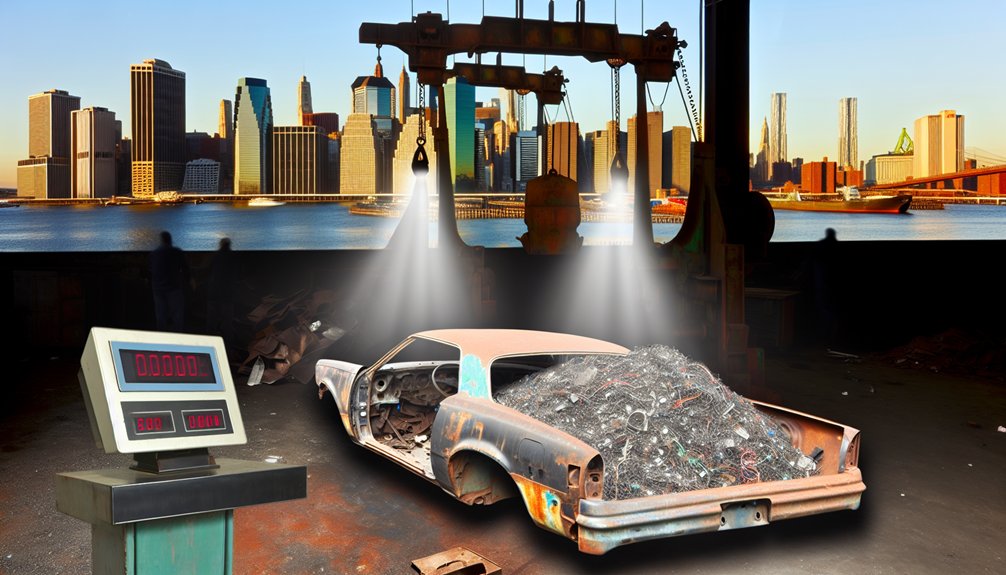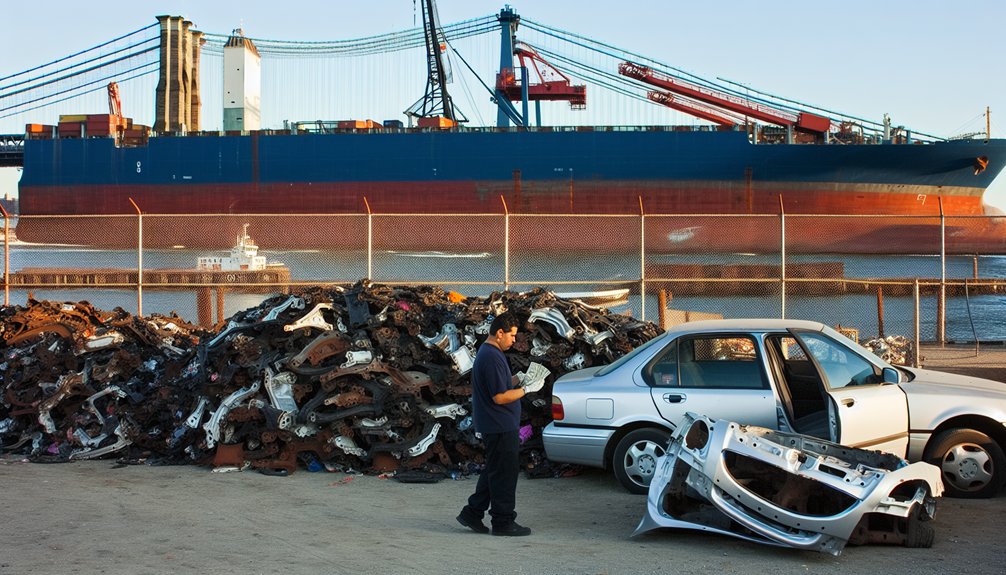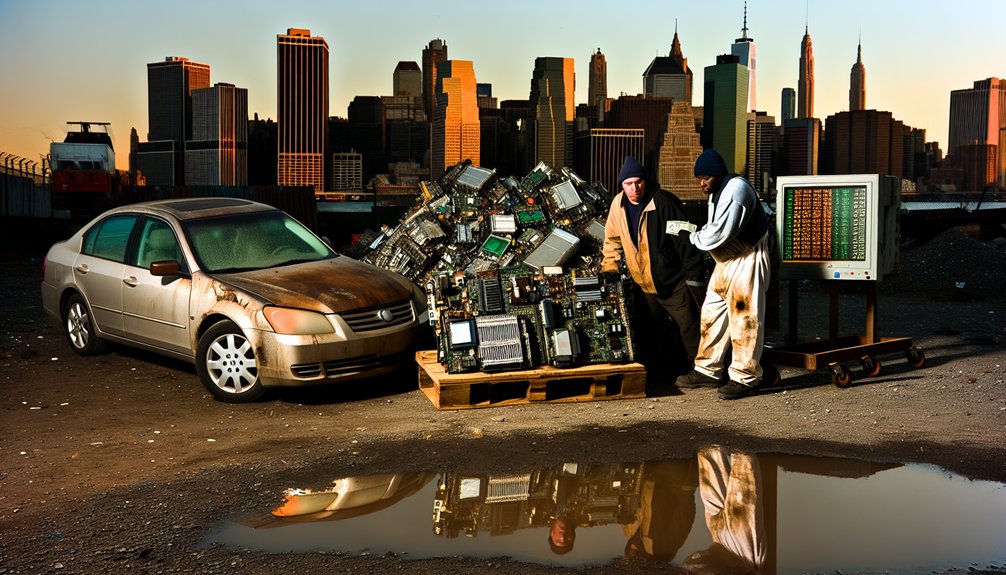Brooklyn’s junk vehicles represent significant monetary value in 2025’s economic landscape. The convergence of escalating scrap metal commodity prices and expanded recycling infrastructure creates a robust market for end-of-life automobiles. Industry analysts report average payouts between $100-$500 per vehicle, with specialized models commanding up to $3,000. This valuation stems from multiple market forces: heightened environmental compliance requirements, advanced component recovery technologies, and Brooklyn’s strategic position within the Northeast transportation corridor. The financial proposition extends beyond mere metal value.
Key Takeaways
- Surging scrap metal prices in the New York Metro Area have increased junk car values to $100-$500 on average in 2025.
- Brooklyn’s strategic location with excellent transportation connectivity facilitates efficient junk vehicle retrieval and processing.
- Vehicles with salvageable components can fetch up to $3,000, with high-value parts yielding returns of $500-$3,000.
- Brooklyn’s automotive parts recycling sector has reached $60 billion in 2025, creating strong demand for junk vehicles.
- Competition among licensed salvage facilities in Brooklyn’s dense urban environment drives premium cash offers for junk cars.
Rising Scrap Metal Prices in the New York Metro Area

Volatility in the commodities market has catalyzed unprecedented growth in scrap metal valuations across the New York Metro Area for 2025. This market shift has greatly elevated the potential cash for cars transactions throughout Brooklyn, with junk vehicles commanding between $100 and $500 on average.
Current scrap metal prices have reached notable highs, transforming previously overlooked junk cars into valuable assets. Particularly, vehicles with substantial salvageable components can fetch upwards of $3,000, representing a marked increase from previous valuation metrics.
Brooklyn’s strategic proximity to major salvage yards creates a competitive marketplace for those looking to sell their junk car. Regional pricing fluctuations favor informed sellers who understand the correlation between their vehicle’s material composition and prevailing commodity rates.
This geographic advantage, combined with heightened demand for recyclable automotive materials, positions Brooklyn residents to maximize returns when divesting unused vehicles in the current economic climate.
Environmental Regulations Driving Sustainable Vehicle Disposal
Beyond the financial incentives of rising scrap metal prices, stringent environmental protocols have fundamentally transformed Brooklyn’s junk car market in 2025.
New York State’s extensive regulatory framework mandates certified disposal methods, requiring junk car processors to implement eco-friendly practices throughout the recycling process. These environmental regulations have created a structured marketplace where compliant operators offer premium cash for your junk vehicle while ensuring hazardous components are properly managed.
New York’s regulations transform junk car removal into a dual-benefit system: environmental protection paired with competitive cash offers.
- Licensed facilities must document complete fluid extraction protocols, preventing groundwater contamination and protecting community health.
- Certified recyclers must achieve minimum 87% material recovery rates from each junk car, considerably reducing landfill burden.
- Quarterly environmental compliance audits verify proper handling of high-risk components including batteries, catalytic converters, and refrigerants.
The regulatory landscape has effectively elevated vehicle recycling from simple waste management to a sophisticated resource recovery system, simultaneously increasing junk car values while advancing sustainability objectives across Brooklyn’s urban ecosystem.
The Surge in Automotive Parts Recycling Market
While global supply chains face persistent disruption, Brooklyn’s automotive parts recycling sector has experienced unprecedented growth, reaching a market valuation of $60 billion in 2025. This expansion stems from heightened environmental consciousness and escalating production costs for new components within the automotive industry.
Salvage operations extracting high-value components—including engines and transmissions—yield substantial returns, with individual parts commanding $500-$3,000 depending on condition and demand metrics.
Statistical analysis indicates recycling automotive metals conserves approximately 75% of the energy required for virgin material production.
The shift toward electric vehicle manufacturing has paradoxically increased demand for recycled conventional vehicle components. Junk car recycling facilities have become essential infrastructure in the circular economy model, providing sustainable material streams for new manufacturing processes.
Industry forecasts suggest Brooklyn’s centralized location within dense transportation networks positions local salvage operations to capitalize on this market evolution through 2025 and beyond.
Brooklyn’s Strategic Location for Auto Salvage Operations

Brooklyn’s strategic positioning at the nexus of three major transportation arteries—I-278, I-478, and the Brooklyn-Queens Expressway—creates an excellent environment for auto salvage operations in 2025. The borough’s connectivity facilitates expedited junk vehicle retrieval and processing, with most salvage yards offering free towing services throughout the five boroughs.
Brooklyn’s strategic transportation nexus creates ideal conditions for efficient junk vehicle retrieval and processing in 2025.
This infrastructure advantage translates directly into higher cash for junk offers, as operational efficiencies reduce overhead costs.
- High population density (37,000+ residents per square mile) generates consistent supply of end-of-life vehicles, enabling competitive pricing models.
- Proximity to maritime facilities, including Red Hook Container Terminal, facilitates export of processed auto salvage components to international markets.
- Strategic location between Manhattan’s commercial hub and Long Island’s suburban centers creates prime logistics triangle for junk car acquisition.
The concentration of licensed salvage facilities within a 15-mile radius enhances competition, compelling operators to offer premium rates for Brooklyn junk vehicles regardless of condition or operational status.
Economic Incentives for Vehicle Owners to Sell Rather Than Store
Numerous economic factors in 2025 have transformed Brooklyn’s junk car landscape into a seller’s market, creating compelling financial incentives for vehicle owners to liquidate rather than store non-operational assets.
Market analysis indicates junk vehicles now command between $50-$3,000, with average transactions ranging from $100-$500—significantly outweighing the cumulative costs of continued storage.
Cash Auto Salvage operations report heightened demand for recyclable components and scrap metal, enabling competitive offers approximately $500 per vehicle. This price point represents immediate liquidity for assets that otherwise generate ongoing expenses.
The inclusion of free towing services by most buyers eliminates logistical barriers and associated transportation costs.
Industry data confirms the best price for selling your junk car is typically secured through expedited transaction processes, with many buyers completing purchases within 24 hours.
This operational efficiency enables owners to rapidly convert deteriorating assets into capital rather than maintaining non-productive inventory that depreciates while consuming valuable urban space.
Technology Advances in Vehicle Component Recovery
Technological breakthroughs in component recovery systems have revolutionized Brooklyn’s automotive recycling industry in 2025, enabling extraction efficiencies previously unattainable in conventional salvage operations.
Automated dismantling systems now precisely extract high-value components from junk cars with minimal damage, preserving market value and maximizing salvage yard returns. These innovations translate directly into higher cash offers for Brooklyn vehicle owners.
Advanced recycling processes utilize spectroscopic analysis to identify and separate materials with unprecedented precision, recovering up to 98% of valuable metals and rare earth elements from automotive components.
- Laser-guided extraction systems remove catalytic converters and electronic modules without thermal damage, increasing recovered value by 37%
- AI-powered diagnostic tools assess engine and transmission viability in under 90 seconds
- Micro-separation technology isolates precious metals from circuit boards at the molecular level
This technological evolution has transformed end-of-life vehicles from disposal problems into valuable commodity sources, substantially increasing the baseline value of even severely damaged junk cars.
Frequently Asked Questions
What Are They Paying for Junk Cars Now?
Current junk car pricing ranges from $100-$500 on average, with newer vehicles potentially fetching over $3,000.
Local scrap values fluctuate based on market demand trends and regional factors. Vehicle condition factors greatly impact offers, with complete automobiles commanding higher prices.
The environmental impact of proper recycling processes adds value to the transaction.
Industry experts recommend obtaining multiple quotes from salvage companies to maximize returns, as pricing varies based on geographical location and current metal markets.
How Much Will a Scrap Yard Pay for a Car?
Can a worthless vehicle truly turn to treasure in a scrap yard’s hands?
Typically, scrap yards pay between $50-$3,000 for vehicles, with payouts determined by several variables.
Car condition and weight factors greatly impact value, as heavier vehicles yield more recyclable material.
Location influence affects pricing due to regional market trends and transportation costs.
Current scrap metal prices remain the dominant determinant, fluctuating based on global commodity markets.
Additionally, vehicles with salvageable components offer enhanced recycling benefits, increasing potential compensation.
What Company Pays Most for Junk Cars?
The companies offering premium cash offers for junk cars typically include specialized national services like Peddle, Junk Car Medics, and Cash Auto Salvage.
These entities evaluate compensation based on vehicle condition, salvageable components, and current scrap metal values. Local businesses may occasionally outbid national competitors by reducing operational overhead.
Ideal providers combine competitive pricing with complimentary removal services while demonstrating commitment to proper environmental impact management through certified recycling protocols and hazardous material handling compliance.
What Happens to Old Junk Cars?
Old junk cars undergo systematic car dismantling, where valuable components are harvested for resale.
The remaining vehicle shell enters metal recovery processes, with ferrous and non-ferrous materials separated for recycling. This process yields significant economic value while providing substantial recycling benefits, including reduced mining demands and energy conservation.
The proper disposal mitigates negative environmental impact through responsible management of hazardous fluids and materials.
Many salvage yards offer community services through affordable parts access and waste reduction initiatives.
Conclusion
Brooklyn’s junk vehicle market has transformed into an unprecedented economic powerhouse in 2025, with scrapped automobiles generating astronomically higher returns than anticipated. Unprecedented metallurgical recovery efficiencies have elevated once-worthless hulks into coveted assets. Industry professionals project this hyper-accelerated valuation trend will continue exponentially, making today’s $3,000 salvage price potentially quadruple by 2027 as resource scarcity and recovery technologies reach their zenith.

